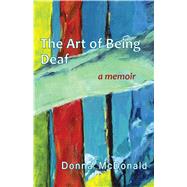Janice Evans
The Art of Being Deaf: A Memoir
Donna McDonald
Gallaudet University Press, Washington DC. 2014
There is no doubt that Donna McDonald excels as a writer. Her memoir, The Art of Being Deaf, published in 2014 by Gallaudet University Press, is one of the best biographies of deafness I have read. It adds to the extremely small body of memoirs about deafness set in Australia and written by Australian authors. At 193 pages long, it is neither too long nor too short. It’s an excellent resource for those people who have little understanding of deafness and its impacts on a person’s identity.
Communicating through speech rather than sign, McDonald has given us a glimpse into the lives of those deaf children in the 1950s and 60s who were educated orally and forbidden to sign. The story is compelling, at times heart-breaking, but overall positive.
McDonald’s journey of exploration of her own identity began with a question posed by her psychologist, “your deafness; it must have had a big impact on you?” The reader may be startled into realising that McDonald had moved through life for 45 years without considering her own deafness. Readers will enjoy exploring with her the reasons why this may be so and what is the impact of her deafness on her present-day life.
McDonald asked herself, “I wonder if I feel so lonely because I don’t have any deaf people in my life?” (p43.) This was when McDonald strived to discover her deaf self: meeting her old deaf friends from her early years at an oral deaf pre-school, attempting to learn some sign language, attending a national Deaf conference and even talking about being deaf on national radio. She finally achieved acceptance of herself after a year of soul searching. “My deafness is more than a backdrop to my sense of self; it is the context in which I am located” (p183), she writes.
How she has finally found her own true self, and how she finally reached the other side of her own personal journey would be of interest to anyone exploring the concept of personal identity and place in the world. She finally writes, “My life is larger than my deaf-self,” and eventually comes to the conclusion that everyone has experiences and challenges in life and how they face and overcome these is unique and special to each individual.
At times the book can become rather emotional and draining, but it is never boring. McDonald has a gift for being able to effortlessly and seamlessly being able to draw in the reader and this is maintained throughout the story. In describing her own journey, she touches on the many situations deaf people experience: hearing people’s distortions of deafness, stigmas of deafness, finding (or re-finding, as in her case) the Deaf Community, parental grieving and eventual acceptance, but it is the insights and depths McDonald gives into these situations which add so much to this story.
The Art of Being Deaf is a wonderful read. It’s brimming with experiences, challenges, explorations and emotions. I would recommend this book to anyone who is interested in and enjoys reading memoirs, or anyone just looking for a good read.
The Art of Being Deaf is available at numerous online bookstores such as Angus & Robinson, The Book Depository, Bookworld and Amazon
Janice Evans is Deaf and a teacher of the deaf with a master of education degree. She is a former President and Secretary of Deaf Victoria, and is married to a sheep and cropping farmer in southern New South Wales, Australia.

Leave a Reply